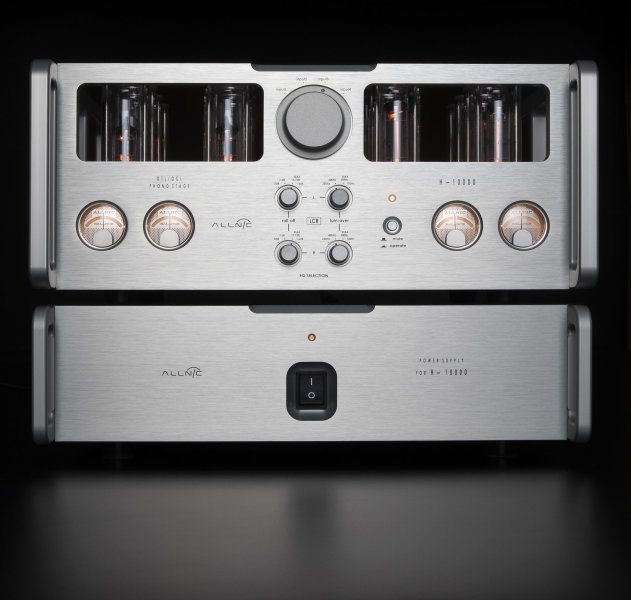
TRANSFORMING ANALOG AUDIO
Allnic Audio’s Acclaimed Phono Preamps
Allnic Audio’s Acclaimed Phono Preamps
Allnic Audio has become justifiably well-known for all its products, but analog has been a specialty from the beginning. There are specific principles behind the design of the Allnic phono-stages, and they all add up to customer satisfaction. That outcome can only be obtained by providing a base level of outstanding design and build quality across the product line, quality whose outcome is remarkable sound and that creates an unbeatable performance to price ratio.
Since the release of the long-discontinued but extremely successful H-1200 and through all the iterations of the phono-preamps, the production of fantastic sound quality has always been feature number one, and all the current Allnic phono-stages provide it, from the lowest cost but brilliant and award-winning H-5500, to the new H-6500 discussed here a few posts back, to the much-lauded H-7000/H-7000V, and finally the flagship H-8000 DHT. Reviewers and customers agree: no matter which Allnic phono-stage one uses, it is certain to transform the sound of one’s vinyl system, elevating it beyond expectations.

H-1200 Phono-stage, the “little giant”!
One fundamental reason for the outstanding sound quality of the Allnic phono-preamps has been the equalization method employed.
ALLNIC AND LCR TYPE RIAA EQUALIZATION:
RIAA equalization is a specification for the correct playback of vinyl records, established by the Recording Industry Association of America. The purpose of the equalization is to permit longer playback times and improve sound quality.
RIAA equalization is a form of establishing a flat frequency response for the playback of recorded music. The necessity for this equalization process arises from mechanical difficulties inherent in record production. To prevent the cutting needle from over-cutting into the next record groove in the bass, as a record is cut, some bass frequencies are attenuated. In the treble region, for high frequency sounds not to be masked by the noise inherent in moving a stylus over and through a modulated vinyl surface, some treble frequencies are boosted. With the application of the correct filtering techniques on playback, the result is a flat frequency response with better signal-to-noise ratios.
A little more explanation...
There are four de-emphasis methods that can be applied at playback:
? Active filters (Negative feedback types):
Different quantities of negative feedback are applied, with deeper feedback to the high frequencies and shallower to the low frequencies. The benefits of this method are improved signal-to-noise ratios, low-cost and consistent operation. Some of the shortfalls are looser bass reproduction and possibly a pinched and compressed high frequency playback due to excess feedback ratios.
B. Passive filters (CR type) - used in the H-5500:
The frequencies are filtered to fit the RIAA specification by varying the amount of attenuation at different frequencies through a complex capacitor-resistor network. This technique results in no voltage overload, purer reproduction (because there is no feedback), and more accurate RIAA compensation. However, there can be problems because the system provides no gain, and insertion loss and impedance matching issues arise. Nonetheless, this is a preferred, common method and, well-executed in a device like the H-5500 that shares other exceptionally high-quality features with its larger siblings, will provide sound quality that meets Allnic’s and users’ rigorous standards.
? Hybrid filters (use of both CR and negative feedback types):
In this method, both types of filters applied separately; an active filter is applied to the low frequencies and a passive filter to the high frequencies. Unfortunately, both the advantages and disadvantages of each of these two types of filters, already discussed, affect the playback system at the same time.
? LCR filters, used in the H-6500, H-7000 / H-7000V, and H-8000 DHT:
Two pieces of a linear reactor (a kind of choke coil) comprise the main part of these filters, assisted by precise CR filters, to lower impedances and insertion loss.
In vacuum tube circuits, active and passive filters usually are operated on one hundred plus kilo ohms of impedance. An LCR RIAA filter's impedance is a constant 600 ohms.
Furthermore, an LCR RIAA filter's series resistance is less than 13 ohms (as a comparative, some famous ones are 31 ohms). The lower the impedance, the more dynamic is the sound reproduction, with better bass response and speed.
But LCR RIAA units have drawbacks as well. These drawbacks are high cost and the difficulty of impedance matching; the latter has been the primary hindrance to the commercialization of this superb method in the construction of phono stage amplifiers. However, Allnic Audio’s high quality LCR RIAA unit and has developed a 600 ohms impedance matching method. The H-7000V and the H-8000 DHT even provide user-variable LCR filter units, so records made prior to RIAA standardization can be played with appropriate filtering.

H-7000V SUT and Multi-curve LCR EQ units
One of the company’s fundamental principles is that the Allnic phono-stages should share certain high-quality features, features that are key contributors to the audio magic each product provides – which is why the H-5500, despite its lower cost and CR EQ, is not a “lesser” product. These shared features include:
? High quality, genuine NOS tubes
? The same in-house manufactured moving-coil step-up transformers (also found in the AUT-2000 SUT, now available with silver wiring AUT-8000, which is optional in the H-6500 and H-7000/7000V and standard in the H-8000 DHT)
? Vacuum tube power supply regulation
? Substantial aluminum chassis that reduce vibration and provide excellent shielding
? In-house manufactured Permalloy transformers
? Analog meter tube monitoring
These common design features are the primary bases for the outstanding excellence and value of ALL Allnic phono-stages’ exceptional analog sound reproduction.

Read about the AUT-8000 Silver MC Step-up Transformer here!


















